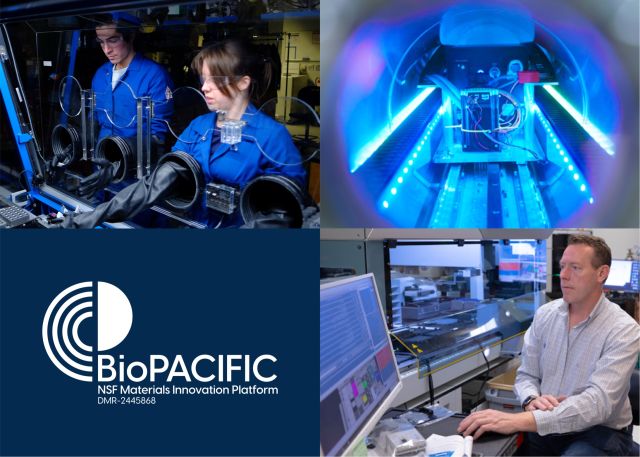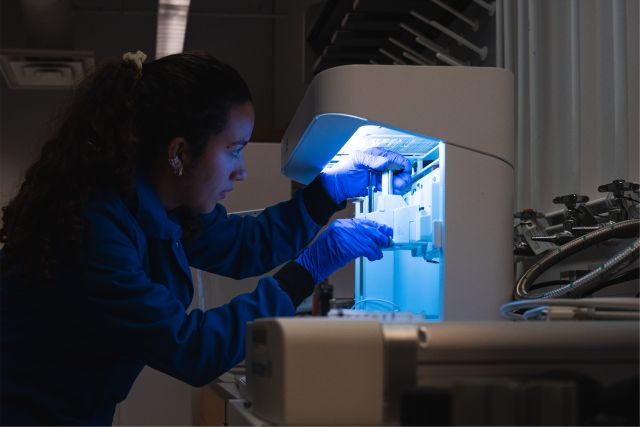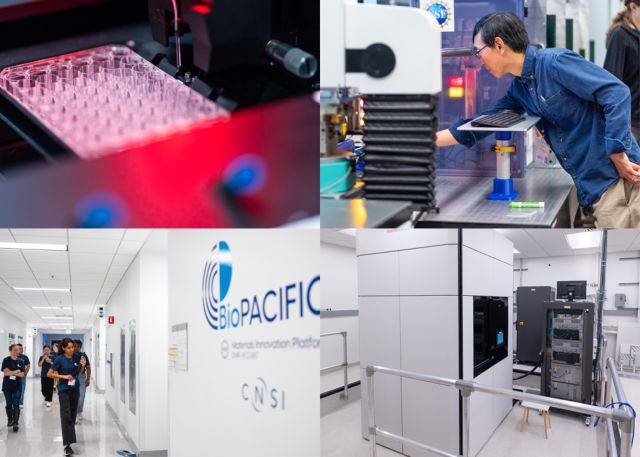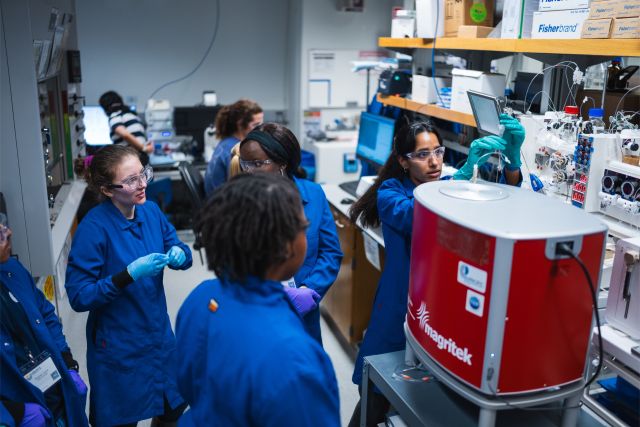National Science Foundation renews funding for BioPACIFIC MIP
UC Santa Barbara, UCLA’s BioPACIFIC MIP earns renewed NSF support to accelerate AI-driven biobased materials innovation

SANTA BARBARA and LOS ANGELES, Calif. (Aug. 20, 2025) — The U.S. National Science Foundation has renewed funding for BioPACIFIC MIP — Biomaterials, Polymers and Advanced Constructs from Integrated Chemistry Materials Innovation Platform — a collaboration between UC Santa Barbara and UCLA that provides a unique scientific ecosystem for the United States. This $19.8 million renewal empowers BioPACIFIC MIP to continue advancing the frontier of biobased materials, uniting synthetic biology, chemistry, automation and artificial intelligence to reshape how materials are discovered, designed and deployed.
Originally launched in 2020 as one of just four MIPs nationwide, BioPACIFIC MIP is entering its second and final five-year phase. The renewed funding reinforces its national role as a user facility and central hub for accelerating materials innovation, expanding its impact on research, workforce training, and the development of real-world solutions to pressing challenges.
“Renewing BioPACIFIC MIP is essential to keeping California and the U.S. at the forefront of sustainable materials innovation,” said Craig Hawker, co-principal investigator (co-PI) and director of the California NanoSystems Institute (CNSI) at UCSB. “This program turns scientific breakthroughs into real-world solutions that benefit the U.S. economy while training the next generation workforce.”
A national platform for next-generation biomaterials
BioPACIFIC MIP accelerates the development of functional materials from biological building blocks. Its mission spans five integrated goals:
- Equipping researchers nationwide with access to cutting-edge instrumentation and expertise through an open-user program
- Developing bio-based materials with high functionality and performance via high-throughput synthetic biology and chemistry
- Bridging the molecular and macroscopic understanding how structure and function interrelate across scales
- Leveraging data science and AI, using autonomous experimentation and machine learning to dramatically reduce discovery timelines
- Training an interdisciplinary workforce for emerging industries at the intersection of biology, chemistry, materials research, and automation
Autonomous experimentation: a new era in materials research
A major emphasis of the NSF BioPACIFIC MIP’s second phase is the integration of robotics and artificial intelligence to enable autonomous experimentation. This transformation is designed to vastly accelerate discovery, eliminate bottlenecks and move promising materials more quickly from the lab to real-world applications.
“This award reflects the remarkable efforts of our project scientists, faculty, students, and MIP community, enabling us to advance biomaterials innovation and usher polymer synthesis into the era of robotic platforms,” said Javier Read de Alaniz, UCSB professor of chemistry and biochemistry and BioPACIFIC MIP co-director and PI.
“Looking ahead, we are energized to expand BioPACIFIC MIP’s impact, accelerating high-throughput experimentation and leaving a lasting legacy of training a generation of scientists at the forefront of materials science.”

BioPACIFIC MIP researchers utilize advanced instrumentation to accelerate materials innovation. Photo credit: Jeff Liang/UCSB
Unlocking innovation through collaboration
Since opening to users in 2021, BioPACIFIC MIP has supported approximately 130 research projects across 22 states— including many from institutions without prior NSF platform access—demonstrating its broad national impact. For example, an assistant professor at University of Southern Mississippi was not only able to launch his scientific career, but also successfully applied for a large piece of equipment for Southern Miss as a result of the expertise, facilities and mentorship received at BioPACIFIC MIP.
“BioPACIFIC MIP is a user facility open to researchers across the U.S.,” said Read de Alaniz. “Our centralized, state-of-the-art facility and in-house expertise allow users to lead their own research programs—bringing together R1 institutions, primarily undergraduate institutions, and non-R1s alike in pursuit of next-generation materials.”
This infrastructure enables cross-pollination of research ideas, accelerating breakthroughs in fields ranging from degradable plastics to advanced microelectronics and sequence-defined polymers.
Impactful research, powerful tools
The facility’s in-house researchers have led major advances, such as:
- Developing on-demand degradable adhesives for packaging and recycling
- Engineering materials for microelectronics with precisely defined molecular sequences—paving the way for higher data density and next-gen computing
- Working with partners like BASF to develop biodegradable plastics that could one day replace non-degradable versions
- Fostering technology translation and entrepreneurship and supporting startups like Praio, FLO Materials, and Saku Biosciences that commercialize materials, workflows and biotechnology developed at BioPACIFIC MIP
The mission of the platform is to connect fundamental research with industry needs, aiming to establish Southern California as a hub for biomaterials innovation. By significantly reducing barriers to university-industry collaboration, the platform opens doors for accelerated commercial development.
“The NSF BioPACIFIC MIP has provided an ecosystem that is unique in the United States,” said Heather Maynard, Dr. Myung Ki Hong Endowed Chair in Polymer Science, co-director of the MIP, co-PI and associate director of CNSI.
“Users from across the country can utilize one-of-a-kind equipment and take advantage of extraordinary expertise in an environment that greatly accelerates research in polymers and biomaterials,” Maynard added. “This benefits our country by providing paradigm shifts in how new materials are discovered and characterized. I am thrilled that the NSF has enabled us to continue this work.”

State-of-the-art research facilities at UC Santa Barbara and UCLA support impactful discoveries in materials science through the BioPACIFIC MIP. Photos by Juan Manuel Urueña Vargas, Jeff Liang, and Marc Roseboro
Training the future workforce
A key component of BioPACIFIC MIP’s mission is workforce development. More than 100 graduate students and postdoctoral fellows have already benefited from interdisciplinary training in automated synthesis, data-driven experimentation, and synthetic biology.
“Because we combine interdisciplinary research with high-throughput experimentation, we’re training students in a way that aligns with industry needs,” said Read de Alaniz. “Our ecosystem equips them with hands-on experience in robotics, AI and polymeric materials synthesis—giving them a true competitive edge.”
“As a National User Facility, BioPACIFIC MIP is providing critical national infrastructure for all researchers to bridge biological synthesis with the making of new, functional materials,” said Rachel A. Segalman, vice chancellor for research at UCSB. “This is incredibly important not just for positioning UCSB at the forefront of this important field, but also training a broad workforce and providing resources for a research community far beyond our campus.”

Graduate students and postdocs gain experience in automation, AI and materials synthesis—skills that align with the needs of emerging industries. Photo credit: Jeff Liang/UCSB
Powering discovery with digital infrastructure
BioPACIFIC MIP has also built a robust digital ecosystem, linking electronic lab notebooks, data sharing, and AI-powered analytics into a cohesive infrastructure.
“This digital backbone allows us to capture successful and unsuccessful experiments alike,” Read de Alaniz explained. “Now, we can build high-quality datasets to fuel machine learning models that will dramatically improve the speed and success of materials discovery.”
The next five years will see further investment in this digital infrastructure, a critical step toward fully autonomous discovery workflows envisioned by the Materials Genome Initiative—a federal effort to shorten the timeline for developing advanced materials. As Yi Tang, professor of chemical engineering and chemistry at UCLA and co-PI, said, “This renewal positions CNSI at the forefront of advancing the next generation of biomanufacturing and AI-programmable laboratories.”
“This renewal affirms the critical role BioPACIFIC MIP plays in advancing scalable platforms for bio-derived and bio-inspired materials,” said Umesh Mishra, dean of The Robert Mehrabian College of Engineering at UCSB. “The collaborative model between UCSB and UCLA continues to enable transformative research at the intersection of biology, chemistry and materials science. I commend our faculty, researchers, and staff for their vision and leadership in building the materials infrastructure of the future and driving innovation with global impact.”
The BioPACIFIC MIP renewal marks a pivotal moment for the platform. As it expands AI-driven experimentation, deepens its user community, and trains the next generation of interdisciplinary scientists, it is uniquely positioned to help the U.S. remain a leader in new materials and advanced manufacturing.
For more information and updates, visit biopacificmip.org.
About the California NanoSystems Institute (CNSI)
The California NanoSystems Institute (CNSI) is an integrated research enterprise at UCLA and UC Santa Barbara, established in 2000 as part of the California Institutes for Science and Innovation. The CNSI was founded to keep California at the forefront of technological innovation by advancing interdisciplinary research and forging strategic partnerships with industry.
With world-class facilities on both campuses, the CNSI fosters transformative research in nanoscience and nanotechnology, focusing on critical challenges in health, clean energy, the environment, and information technology. The Institute accelerates the translation of groundbreaking discoveries into knowledge-driven enterprises while cultivating the next generation of scientists, engineers, and entrepreneurs.
Across both campuses, the CNSI prioritizes investments that combine scientific excellence with societal impact and commercial potential—fueling the development of new medical devices, biomedical platforms, diagnostics, analytical tools, and AI technologies. By supporting early-stage, high-risk research, the CNSI serves as a launchpad for solutions that address some of the world’s most pressing challenges.
Media Contacts
UC Santa Barbara:
Seren Snow
(805) 893-2206
serensnow@ucsb.edu
UCLA:
Nicole Wilkins
(310) 869-6835